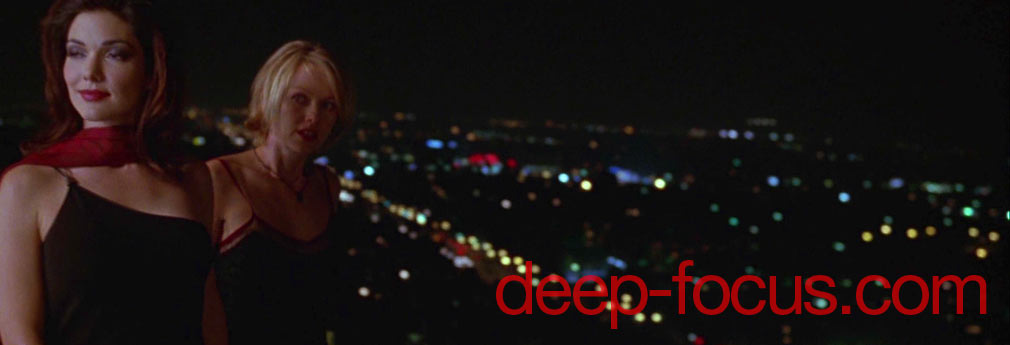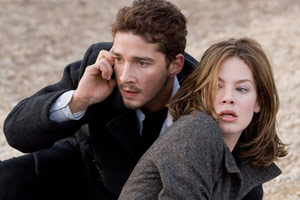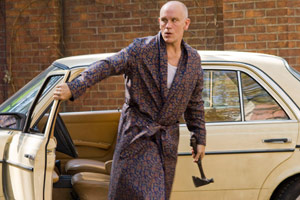Recently in Bryant Category
My review of P.S. I Love You on Blu-ray Disc is online at filmfreakcentral.net:
If you're thinking what I'm thinking, you're wishing somebody would step up right about now and say, "You know what? Not only is this kind of creepy, it's also probably not helpful."
My review of The Other Boleyn Girl on Blu-ray Disc is online at filmfreakcentral.net:
I don't think much of The Tudors, but at least it boasts lots of sex and scandal, with [Jonathan] Rhys Meyers reliably chewing up the scenery. The Other Boleyn Girl is just a soap opera without the suds, a melodrama without much drama. Although the (cheesy, Photoshopped) video cover promises a bodice-ripper, this is at best a skirt-tugger, a button-fiddler.
The visual style of your films [shot with DP Christopher Doyle] — the saturated colors, the way the camera moves, looking through glass or at reflections — is very much present in My Blueberry Nights. What specifically is in the frame, how should the colors look — is that a conversation that you had with [DP] Darius Khondji?... and Manda Bala director Jason Kohn, whose film I caught up with -- and liked a lot -- after watching it win big at the Cinema Eye Awards last month.
WONG KAR WAI: Not so much about that. Darius is a very sensitive DP and very talented. And also, given the schedule and the locations that we shot in, it seems to me the final look of the film was a natural choice. When we shot in New York, the restaurant was so small it was hard to squeeze in all these cameras and a big crew, so we shot mainly [from] outside. It also makes sense to the story, because at that point we are still behind something, to observe what’s going on. And then the frame of the pictures — New York is pretty much like Hong Kong. It’s a vertical city, with vertical lines. And then when the character Elizabeth moves on to other parts of the country, we see the vertical lines become horizontal. And that’s why we shot in Cinemascope [2.35:1 aspect ratio].
We don’t talk much about the framing of things, because I think framing is something the director should be responsible for. It’s a matter of choice, a point of view. And the rest I just leave to Darius.
A lot of documentaries these days seem to be made to argue a specific political point of view. It's like an instrument for mounting an argument rather than —
Somebody from the PBS POV blog [POV series producer Yance Ford, in this post] mentioned that the lowest-rated POV show is seen by more people than 99 percent of the theatrically released documentaries out there. It's a really important point. I don't believe activism is a necessary or even a very useful part of the nonfiction film genre. I don't think nonfiction films were born out of an activist tradition and, quite frankly, I don't think it's an effective forum for activism.
So you don't see your motivation in making your film as activist at all? Or trying to catalyze change?
Absolutely not. No way whatsoever. Let's say the activist's dream scenario came true, and Jader Barbalho was ousted from power, which is the only specific goal that one could possibly, in an alternate reality, expect this movie to have. Nothing would change. The problems in Brazil are institutional. This wasn't about trying to effect change, because I genuinely don't believe documentary film is a great form for that. But I do think it's an important historical marker. It exposes very real connections between large-scale political corruption and violence. But first and foremost I made a film. My personal politics are in there because they are my politics, but I was way more driven by the oddness of the frog farm, the ingenuity of the plastic surgeon, and the opportunity to film in a city that I didn't think many people really understood was as rich or powerful as it is.
A little quiet 'round here lately -- it's a busy time of year leading up to the big NAB convention in Las Vegas, which I cover for Film & Video. Anyway, Grindhouse good (but dead in the water at U.S. theaters), The Reaping not good (but nicely photographed with good digital locusts), Shooter entertainingly absurd (with a comic-book style appreciation of cheap thrills and a fun but inconsequential macho/anti-authoritarian streak), Hot Fuzz intermittently hilarious (but too often as tedious as the turgid action movies it slavishly parodies).
I had intended to write, in honor of Grindhouse, a roundup of some of the Something Weird DVD double features I've enjoyed over the years. Maybe someday. For now, here's a Jarvis Cocker video that dovetails nicely with the car ambush scene from Children of Men, which featured his Running the World over the end credits.
Enjoy.
If you're reading this, it's quite possible that you're looking at the new Deep Focus splash page for the very first time. For some time now, I've been considering the possibilities for controlling my entire movie-review archive using powerful blogging software like Movable Type and Wordpress. Based on a review of my site's stats — fueled by a growing dissatisfaction with my recently redesigned home page — I found that more than 90 percent of my traffic was coming from visitors who were browsing at a screen resolution higher than 800 pixels wide, which I realized gave me the freedom to design a wider home page. (Sorry 10 percenters, but I think reviews should still be readable without side-scrolling.) And when I started mucking around in earnest with my Movable Type templates, I realized that they had the various design fixes and kludges already built in to make my preferred three-column layout work across different browser platforms. Once I figured out a way to populate a "Recent Reviews" box automagically, I was pretty well hooked. Using Movable Type for the entire Deep Focus Web site would not only simplify the process of updating my home page, but would also give me an easy way to populate the front page of the site with links to lots and lots of content. It came closer to what I had always wanted to do, manually, with the old Deep Focus, but rarely found the time to apply myself to.
Tonight, Friday, August 25, I'll be introducing a showing of Clash of the Titans at the Rubin Museum of Art in New York City. (No, I don't know what they were thinking, either.)
The museum is on West 17th Street in Chelsea, and is dedicated to art of the Himalayas and surrounding regions. Cool, huh? Clash of the Titans is screening as part of a film series called The Icarus Syndrome, which is tied in to a current exhibition: Take to the Sky: FLYING MYSTICS in Himalayan Art. I don't know a lot about flying mystics, but I'll be talking up Ray Harryhausen for sure, since he's some kind of mystic on his own.
Admission is free with, hey, a $7 bar minimum. I'm not sure whether it's screening on film or video (I suspect the latter) so be warned. Stop by and say hello if you're in the mood. Details at the museum's Web page, linked above.
So things have been a little chaotic here at Deep Focus World Headquarters. Yesterday afternoon (July 12) we had a tornado literally tear through our back yard. I am not making this up. If you're at all curious, please check out the Flickr photo set I created with a handful of snapshots of our immediate surroundings. We were very fortunate that D.F.W.H. suffered only very minor damage. Given that nothing bad actually happened to my wife and I, it's surprising how stressful the experience has been.
In other Bryant-related news, an interview I did a while back with Bill Plympton has just gone online over at Film & Video.



